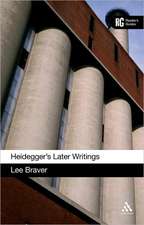Therapeutic Aesthetics: Performative Encounters in Moving Image Artworks: Radical Aesthetics-Radical Art
Autor Maria Walshen Limba Engleză Paperback – 29 iun 2022
| Toate formatele și edițiile | Preț | Express |
|---|---|---|
| Paperback (1) | 197.77 lei 6-8 săpt. | |
| Bloomsbury Publishing – 29 iun 2022 | 197.77 lei 6-8 săpt. | |
| Hardback (1) | 598.28 lei 6-8 săpt. | |
| Bloomsbury Publishing – 11 noi 2020 | 598.28 lei 6-8 săpt. |
Preț: 197.77 lei
Nou
Puncte Express: 297
Preț estimativ în valută:
37.85€ • 39.37$ • 31.72£
37.85€ • 39.37$ • 31.72£
Carte tipărită la comandă
Livrare economică 14-28 martie
Preluare comenzi: 021 569.72.76
Specificații
ISBN-13: 9781350189430
ISBN-10: 135018943X
Pagini: 240
Dimensiuni: 156 x 234 mm
Greutate: 0.34 kg
Editura: Bloomsbury Publishing
Colecția Bloomsbury Academic
Seria Radical Aesthetics-Radical Art
Locul publicării:London, United Kingdom
ISBN-10: 135018943X
Pagini: 240
Dimensiuni: 156 x 234 mm
Greutate: 0.34 kg
Editura: Bloomsbury Publishing
Colecția Bloomsbury Academic
Seria Radical Aesthetics-Radical Art
Locul publicării:London, United Kingdom
Caracteristici
There are currently no other academic texts using the range of art works that Walsh uses in her conceptual framework.
Notă biografică
Maria Walsh is Reader in Artists' Moving Image at Chelsea College of Arts, University of the Arts London, UK. Her research on artists' moving image and critical theory has been published in the peer-reviewed journals Rhizomes, Angelaki, Screen, Refractory, film-philosophy, NECSUS and MIRAJ.
Cuprins
Introduction 1. Setting the scene - two supplementary vignettes 2. The imbrication of poison and cure in Harun Farocki 3. Homeopathic mimicry in Omer Fast's war trilogy 4. Melanie Gilligan's signifying semiologies and the micro-resistance of collective subjectivity 5. Pharmacological reparation in Liz Magic Laser's Primal Speech 6. Leigh Ledare's pharmacological aesthetics of group analysis 7. Aesthetic modes of performative truth-telling in The O Show and Self Made 8. The transitional pleasures of emotional labour in Lucy Beech's and Rehana Zaman's videos Conclusion: Toxicity and self-care - two poles of pharmacological aestheticsReferences Index
Recenzii
Maria Walsh's book marks a decisive step forward in the study of art as a means of addressing trauma. Through sustained analyses of moving image works, she advances a compelling understanding of their power to relieve psychological damage without airbrushing the social and economic forces underlying it.
In a series of encounters between moving image practices and a diverse selection of ideas and theories this wide ranging book diagnoses and develops an original concept of pharmological aesthetics. Walsh is highly attuned to what is fast becoming one of the most urgent issues of today - how certain forms of psychic malaise are increasing as other new ones are emerging - and has identified within certain artistic strategies not so much a cure as a complex treatment for them. A very timely work for those interested in the intersections between therapeutics and contemporary art and indeed in contemporary practices of micro-resistance to our latest form of capitalism.
Applying a feminist politics and drawing on a series of metaphors from medical and therapeutic discourses, Walsh's inspired book Therapeutic Aesthetics shifts attention from traditional definitions of art as transcending the everyday to focus on art as embedded in our current regime of cognitive capitalism.
Maria Walsh draws on a wide range of cultural, philosophical and political references, which she skilfully weaves to put forth her newly developed concept of therapeutic aesthetics.
Walsh masterfully jostles with different bodies of theory - from sociology to psychology, psychoanalysis, philosophy, semiology, as well as media and political theory ... Therapeutic Aesthetics opens a new pathway in aesthetic discourses.
In a series of encounters between moving image practices and a diverse selection of ideas and theories this wide ranging book diagnoses and develops an original concept of pharmological aesthetics. Walsh is highly attuned to what is fast becoming one of the most urgent issues of today - how certain forms of psychic malaise are increasing as other new ones are emerging - and has identified within certain artistic strategies not so much a cure as a complex treatment for them. A very timely work for those interested in the intersections between therapeutics and contemporary art and indeed in contemporary practices of micro-resistance to our latest form of capitalism.
Applying a feminist politics and drawing on a series of metaphors from medical and therapeutic discourses, Walsh's inspired book Therapeutic Aesthetics shifts attention from traditional definitions of art as transcending the everyday to focus on art as embedded in our current regime of cognitive capitalism.
Maria Walsh draws on a wide range of cultural, philosophical and political references, which she skilfully weaves to put forth her newly developed concept of therapeutic aesthetics.
Walsh masterfully jostles with different bodies of theory - from sociology to psychology, psychoanalysis, philosophy, semiology, as well as media and political theory ... Therapeutic Aesthetics opens a new pathway in aesthetic discourses.




































